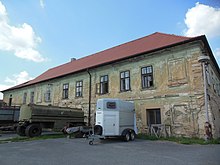Alexandr Brandejs

Alexandr Brandejs (also: Alexander Brandeis, Alexandr Brandeis, Alexander Brandejs ; born September 7, 1848 in Hřebečníky , then Austrian Empire , now the Czech Republic ; † May 19, 1901 , Prague , then Austria-Hungary ) was a Czech landowner, entrepreneur and patron Czech artist.
Life
Alexandr Brandejs came from the wealthy Jewish Brandejs family. He was born in Hřebečníky, where his family owned a farm and a stud in the 19th century.
In 1866 the Brandejs family rented an estate in Suchdol . Alexandr Brandejs lived on this estate, where he had his art collection and where Czech artists met. Alexandr Brandejs supported the Czech artists financially and by arranging them for orders from nobles. He also organized free potato deliveries to Prague for these artists, which is why he was nicknamed "Potato Patron".
Most of the artists of the national theater generation (Generace Národního divadla) met at Brandejs . These artists included the painters Mikoláš Aleš , František Ženíšek , Václav Brožík , Josef Václav Myslbek , Emanuel Krescenc Liška , Antonín Chittussi , Antonín Lhota , Jakub Schikaneder , the architects Jan Zeyer , Antonín Wiehl , the writers Julius Zeyer , Jarrchlický .
The works of painters Ženíšek, Schikaneder, Brožík and Aleš include portraits of members of the Brandejs family. A Brandejs horse served Myslbek as a model for the statue of St. Wenceslas on Wenceslas Square in Prague .
recognition
In 2004, the Jewish Museum in Prague organized an exhibition in the Robert Guttmann Gallery on the subject of Alexandr Brandejs and Adolf Wiesner: The Art Patron and His Son-in-Law .
Brandejsovo náměstí (Brandejs Square) was named after Brandejs in the Prague district of Suchdol. ⊙
The manor house in Suchdol, which was inhabited by Brandejs, is called Brandejsův statek (Brandejs farm). ⊙ It is a stately court that was founded in the 10th century. The buildings were originally built in the Gothic style, later in Baroque style. They were restored after a fire in 1822. They have been used by the Czech Agricultural University in Prague since the second half of the 20th century .
family
Brandejs was married to Jenny, nee Witz. His eldest daughter Helena (1877–1975) was married to the painter Adolph Wiesner . The couple were deported to Theresienstadt concentration camp in 1942, where Adolph Wiesner died in 1942. Helena survived and lived in England after the war. The son of Helena and Adolph Wiesner, René Wiesner (1904–1974) was an architect and expert in glass concrete structures. Brandejs' granddaughter was married to the architect and illustrator Emil Weiss (1896–1965).
Individual evidence
- ^ Literature by and about Alexander Brandeis in the catalog of the German National Library gnd information. Retrieved January 8, 2020.
- ↑ a b c d Alexandr Brandejs and Adolf Wiesner: The art patron and his son- in -law at radio.cz. Retrieved January 8, 2020.
- ↑ History of Hřebečníky at obec-hrebecniky.cz. Retrieved January 8, 2020.
- ↑ zámek Hřebečníky at stredoceske-zamky.cz. Retrieved January 8, 2020.
- ↑ a b Starý Suchdol at archive.org. Retrieved January 8, 2020.
Web links
| personal data | |
|---|---|
| SURNAME | Brandejs, Alexandr |
| ALTERNATIVE NAMES | Brandejs, Alexander; Brandeis, Alexandr; Brandeis, Alexander |
| BRIEF DESCRIPTION | Czech landowner, entrepreneur and patron |
| DATE OF BIRTH | September 7, 1848 |
| PLACE OF BIRTH | Hřebečníky , Austrian Empire |
| DATE OF DEATH | May 19, 1901 |
| Place of death | Prague , Austria-Hungary |
